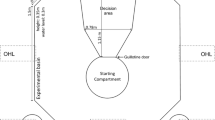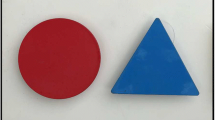Abstract
Object categorization is an important function of the visual system, quickly providing an animal with relevant information about its surrounding and current situation, as for example during predator detection. While the ability to categorize objects has already been observed in several vertebrate and even invertebrate species, no attempt has previously been made to evaluate this function in fish, the most species-rich vertebrate group. This study assessed form discrimination abilities and object categorization skills in the African cichlid Pseudotropheus sp. Fish could discriminate between a variety of two-dimensional geometrical shapes, forms and sizes and learned to distinguish between two categories, “fish” versus “snail”. Performance remained undisturbed by extensive modifications to the stimuli, as long as key features were maintained. Results indicate that fish not only memorized the features of the positive stimulus (categorized the positive stimulus), but also categorized the negative stimulus. During transfer trials involving a previously unknown object, fish were able to discriminate between both the negative and the positive stimulus and the unknown stimulus and responded accordingly.




Similar content being viewed by others
References
Aust U, Huber L (2001) The role of item- and category-specific information in the discrimination of people versus nonpeople images by pigeons. Anim Learn Behav 29:107–119
Bhatt RS, Wasserman EA, Reynolds WF Jr, Knauss KS (1988) Conceptual behavior in pigeons: categorization of both familiar and novel examples from four classes of natural and artificial stimuli. J Exp Psychol Anim Behav Proc 14:219–234
Bovet D, Vauclair J (1998) Functional categorization of objects and of their pictures in baboons (Papio anubis). Learn Motiv 29:309–322
Brown C, Laland K, Krause J (2006) Fish cognition and behavior, 2nd edn. Blackwell Publishing Ltd, Oxford
Cook RG, Smith JD (2006) Stages of abstraction and exemplar memorization in pigeon category learning. Psychol Sci 17:1059
D’Amato MR, Van Sant P (1988) The person concept in monkeys (Cebus apella). J Exp Psychol Anim Behav Proc 14:43–56
Grasso FW, Basil JA (2009) The evolution of flexible behavioral repertoires in cephalopod molluscs. Brain Behav Evol 74:231–245
Herrnstein RJ, Loveland DH (1964) Complex visual concept in the pigeon. Science 146:549–551
Herter K (1929) Dressurversuche an Fischen, Report aus dem zoologischen Institut der Universität Berlin
Herter K (1930) Weitere Dressurversuche an Fischen, Report aus dem Zoologischen Institut der Universität Berlin
Hoffmann KL, Logothetis NK (2009) Cortical mechanisms of sensory learning and object recognition. Philos Trans R Soc Lond Biol 364:321–329
Huber L, Lenz R (1996) Categorization of prototypical stimulus classes by pigeons. Q J Exp Psychol 48:134–147
Jitsumori M, Matsuzawa T (1991) Picture perception in monkey and pigeons: transfer of right-up versus upside-down discrimination of photographic objects across conceptual categories. Primates 32:473–482
Jones CD, Osorio D (2003) Discrimination of oriented visual textures by poultry chicks. Vis Res 44:83–89
Kaiser W, Liske E (1974) Die optomotorischen Reaktionen von fixiert fliegenden –Bienen bei Reizung mit Spektrallichtern. J Comp Physiol A 89:391–408
Königs K (2003) Visual discrimination experiments concerning cognitive abilities in teleost fish (Lepomis gibbosus). Diplom Thesis, University of Bonn
Lazareva OF, Freiburger LK, Wassermann EA (2004) Pigeons concurrently categorize photographs at both basic and superordinate levels. Pyschon Bull Rev 11:1111–1117
Lubow R (1974) High-order concept formation in the pigeon. J Exp Anal Behav 21:475–483
Mauck B, Dehnhardt G (1997) Mental rotation in a California sea lion (Zalophus Californianus). J Exp Biol 200:1309–1316
Meesters A (1940) Über die Organisation des Gesichtsfeldes der Fische. Z Tierpsychol 4:84–149
Mervis CB, Rosch E (1981) Categorization of natural objects. Ann Rev Psychol 32:89–115
Murai C, Tomonaga M, Kamegai K, Terazawa N, Yamaguchi MK (2004) Do infant Japanese macaques (Macaca fuscata) categorize objects without specific training? Primates 45:1–6
Nitsch F, Jarosch E (1972) Individuelle Lernstrategien von Totenkopfäffchen bei der Diskriminierung von visuellen Sequenzen. Psychol Res 35:335–354
Philips KA (1996) Natural conceptual behavior in squirrel monkeys (Saimiri sciureus): an experimental investigation. Primates 37:327–332
Roberts WA, Mazmanian DS (1988) Concept learning at different levels of abstraction by pigeons, monkeys, and people. J Exp Psychol Anim Behav Proc 14:247–260
Schaller A (1926) Sinnesphysiologische und psychologische Untersuchungen an Wasserkäfern und Fischen. Report aus dem zoologischen Institut der Universität München
Schustermann RJ, Thomas T (1966) Shape discrimination and transfer in the California sea lion. Psychon Sci 5:21–22
Siebeck UE, Litherland L, Wallis GM (2009) Shape learning and discrimination in reef fish. J Exp Biol 212:2113–2119
Smith EE, Medin DI (1981) Categories and concepts. Harvard University Press, Cambridge
Sovrano VA, Bisazza A (2008) Recognition of partly occluded objects by fish. Anim Cogn 11:161–166
Spinozzi G (1996) Categorization in monkeys and chimpanzees. Behav Brain Res 74:17–24
Spinozzi G, Lubrano G, Truppa V (2004) Categorization of above and below spatial relations by tufted capuchin monkeys (Cebus apella). J Comp Psychol 118:403–412
Srinivasan MV (2010) Honey bees as a model for vision, perception, and cognition. Annu Rev Entomol 55:267–284
Sutherland NS (1964) Visual discrimination of animals. Br Med Bull 20:54–59
Tanaka K (2000) Mechanisms of visual object recognition studied in monkeys. Spat Vis 13:147–163
von Frisch K (1914) Der Farbensinn und Formensinn der Biene. Zoologischer Jahresbericht der Abteilung für Allgemeine Zoologie und Physiologie 35:1–182
Vonk J, MacDonald SE (2002) Natural concepts in a juvenile gorilla (Gorilla gorilla gorilla) at three levels of abstraction. J Exp Anal Behav 78:315–332
Wasserman EA, Kiedinger RE, Bhatt RS (1988) Conceptual behavior in pigeons: Categories, subcategories, and pseudocategories. J Exp Psychol Anim Behav Proc 14:235–246
Wyzisk K (2005) Experimente zur Formen- und Größenwahrnehmung beim Goldfisch (Carassius auratus) unter Verwendung von Scheinkonturen und Größentäuschungen. PhD Thesis, Johannes Gutenberg Universität Mainz
Wyzisk K, Neumeyer C (2007) Perception of illusionary surfaces and contours in goldfish. Vis Neurosci 24:291–298
Yoshikubo S (1985) Species discrimination and concept formation by rhesus monkeys (Macaca mulatta). Primates 26:285–299
Zoccolan D, Oertelt N, DiCarlo JJ, Cox DD (2009) A rodent model for the study of invariant visual object recognition. Proc Nat Acad Sci USA 106:8748–8753
Acknowledgments
We would like to thank Stefanie Gierszewski for help with the graphics in Fig. 1. The research reported herein was performed under the guidelines established by the current German animal protection law.
Author information
Authors and Affiliations
Corresponding author
Rights and permissions
About this article
Cite this article
Schluessel, V., Fricke, G. & Bleckmann, H. Visual discrimination and object categorization in the cichlid Pseudotropheus sp.. Anim Cogn 15, 525–537 (2012). https://doi.org/10.1007/s10071-012-0480-3
Received:
Revised:
Accepted:
Published:
Issue Date:
DOI: https://doi.org/10.1007/s10071-012-0480-3




